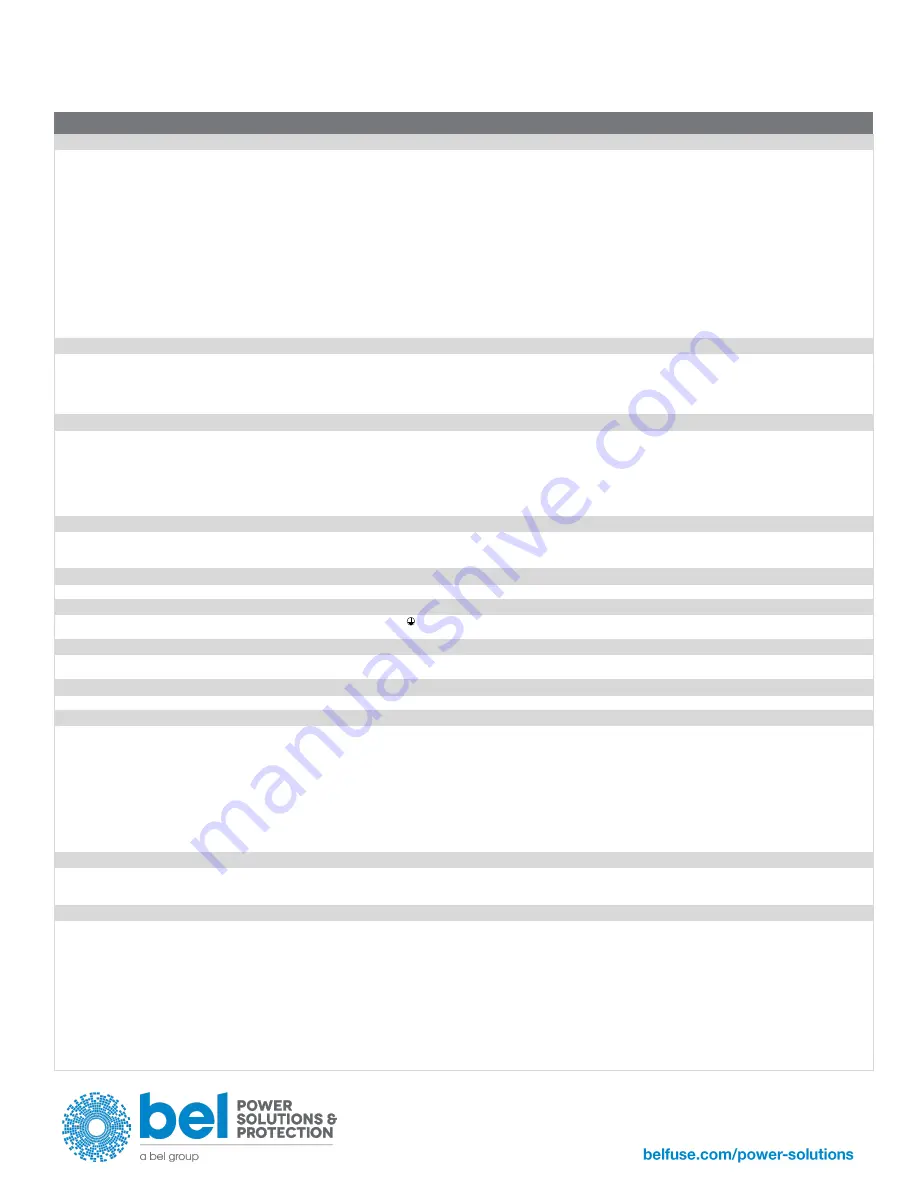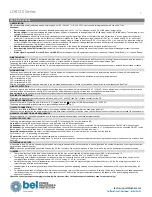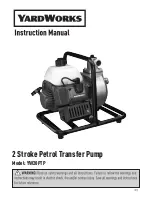
LDB120 Series
2
tech.support@psbel.com
USER INSTRUCTIONS
1) DESCRIPTION
DIN rail mountable primary switched-mode power supply with 100
–
264 VAC (110
–
345 VDC) input, suitable for single phase main line and DC line.
Functions:
•
Power supply:
these units can be used as standard power supplies with 12
–
15 V/7A (
-12
model) and 24 V/5 A (
-24
model) output rating.
•
Battery charger:
for a proper charging the output voltage of the power supply has to be adjusted at
~14 V
(
-12
model) and at
~27 V
(
-24
model). The charging current
regulator limits the charging current to ~0.8 A.
•
DC UPS function:
in case of the power supply incapacity of supplying the load (mains failure or unit failure) the load will continue to receive power from the battery
without AN
Y interruption, until the mains recovers or the battery reaches the “Deep
Discharge Voltage” threshold (10
.5 V for -12 Version and 20.5 V for -24 Version).
•
Deep discharge protection:
disconnects the battery from the load when its voltage is lower than 10.5 V (-12 Version) or 20.5 V (-24 Version). The higher the charging
current the higher the temperature of the battery, therefore the battery life increases if deep discharge is avoided (the battery life depends also by the numbers of the
charge/discharge cycles, their durations and by other various factors).
•
Battery reverse polarity protection:
in case of reverse connection of the battery the resettable fuse will trip and protect all circuitry.
•
Auto-resetting short circuit
protection:
connected in series to the line fed by the battery (the power supply output is actively protected against short circuit and
overload)
•
Status signals:
a
green LED
, a
red LED
and a
dry SPST
contact displays the working status of the product, indicating “Load on Power Supply“
or “Load on Battery”
.
2) INSTALLATION
Use DIN-rails according to EN60715. Installation should be made vertically (see Fig.4). For better device stability fix the rail to the wall close to the point where the device is
to be mounted. In order to guarantee sufficient convection, it is recommended to keep a minimum distance to other modules (see Fig.3).
The device is provided with a thermal protection; a limited air flow can cause the thermal protection tripping.
The SMPS automatically restarts after cooling. To get normal operation reduce the temperature of the air surrounding the power supply, increase the ventilation or reduce
the load (see Fig.8)
3) CONNECTIONS
The device is equipped with screw terminal blocks. To avoid sparks, do not connect or disconnect the connectors before having previously turned-off input power and
waited for internal capacitors discharge (minimum 1 minute)
In order to comply with UL certification, use appropriate copper cables of indicated cross section, designed for operating temperatures of:
60°C for ambient up to 45°C
75°C for ambient up to 60°C
90°C for ambient up to 70°C
Strip the connecting ends of the wires according to the indication and ensure that all strands of a stranded wire enter the terminal connection (see Fig.5)
4) INPUT PROTECTION
The device input is provided with varistors against overvoltage. Input is provided with internal fuses 3.15 AT / 250 VAC, thus an external short circuit/overcurrent protection
must be provided by the end user (see Fig.6). For operation on a single-phase system, a protection fuse on the phase must be provided.
Surge protection:
it is strongly recommended to provide external surge arresters (SPD) according to local regulations.
5) AC INPUT CONNECTION
The device can be connected to single-phase AC lines with Vin 120
–
240 VAC (see Fig.7). Please connect first the PE.
6) DC INPUT CONNECTION
Connect L terminal to (+) positive pole, N terminal to (-) negative pole and
terminal to GND. Rated voltage 110
–
345 VDC.
The device is also suitable for photovoltaic or wind turbine applications (see Fig.7).
7) OUTPUT CONNECTION
The device is suitable for
SELV
and
PELV
circuitry. Vout can be adjusted with a potentiometer to a wide range (see Fig.1)
Check Vout before connecting the power supply to the load. With output voltage set to the max. value, the continuous [current x voltage] must not exceed the nominal power.
8) PARALLEL CONNECTION AND REDUNDANCY
Not recommended. For redundant connection, use an external isolating device must be used (see accessory device).
9) OUTPUT PROTECTION
The device is protected against overload (OL) / short circuit (SC) / overvoltage (OV) / overtemperature (OT).
OL and SC:
are controlled by a hiccup mode auto-reset protection with the following behaviour.
OL behaviour:
Max. OL = In x 1.5 with constant output voltage. If the current is
In x 1.5 the unit enters the OL protection and starts an ON/OFF cycle (hiccup mode).
SC behaviour:
the device supplies the indicated short circuit peak current for 50ms if the output current exceeds In x 1.5 the device enters into a controlled ON/OFF cycles
(hiccup mode). The output voltage drops to a voltage value depending on the impedance of the failed load circuit.
Output OV circuit protection
: the output is protected against potential OV due to internal malfunction or coming from the load for
Vout
Vnom x 1.2
–
1.3, depending on the model.
OT protection:
turns off the device if the internal temperature exceeds a safe limit.
The device restarts automatically after cooling down. To recover to normal operation, reduce air temperature surrounding the power supply, increase cooling or reduce load
(see Fig.8).
10) FEEDING DC MOTORS
It is possible to feed DC motors considering that when a motor starts-up under effort its consumption is much higher than the nominal current and it can trigger overcurrent
protection (see accessory device).
NOTE:
motors can generate high conducted noise on the DC line. Therefore, it is not recommended to feed on the same line motors and equipment sensitive to noise.
11) NOTES
•
The total current sunk by the load and by the battery during the max. current required by the charging process (0.8 A), must not exceed 7 A
(-12 Version), 5 A (-24 Version) continuous, thus the max. continuous load must be 6.2 A (-12 Version) / 4.2 A (-24 Version).
•
The charging time of the battery depends on its capacity in Ah, on its charge level, on ambient temperature, on the efficiency status of the battery, its age, on the
charging voltage of the device (recommended: 14.4 V for -12 version, 27.5 V for -24 version).
•
Normally the charging current of lead batteries must not exceed 10% of rated Ah. Higher charging current reduces battery life, too low charging current leads to a
longer charging time and incomplete charge.
•
Lead batteries in normal charge conditions and efficiency have a good self-regulating capacity on charging current, independently form the current supplied by the
charger.
•
To calculate the duration of voltage/current that a battery can supply, refer to the data sheet of the battery. Basically, the Ah that a lead battery can supply depends on
its efficiency status, on the charge level and other factors such as T ambient (low ambient temperatures reduces the capacity of the battery) ageing reduces the
capacity of the battery.
Check the correct parameters charging, discharging, life time and other on the datasheet of the battery used for a proper using.






















